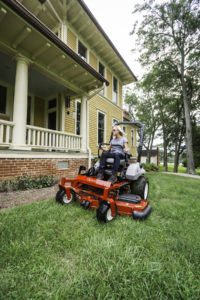Many gardeners spend considerable time and money to produce a healthy, attractive lawn. Fertilizers are applied to promote root and shoot growth and produce a dark green lawn. When necessary, herbicides are used to control crabgrass and broadleaf weeds. While fertilization and weed control are important aspects of lawn maintenance, proper mowing is another vital key. In fact, many turfgrass problems can be traced back to improper mowing.
The Importance of Cut Height
Mowing height and frequency are the most important aspects of mowing. Bluegrass lawns should be maintained at 2 to 2 1/2 inches in the spring and fall months. Raise the mower blade to a height of 3 inches during summer. Mowing frequency is based on the growth rate of the turfgrass.
The 1/3 Rule
As a general rule, never remove more than 1/3 of the total leaf surface at any one mowing. For example, to maintain a lawn at 2 inches, the grass should be mowed when it reaches a height of 3 inches. In the spring it may be necessary to mow every 4 to 5 days, possibly only once every 1 to 2 weeks in summer, with more frequent mowing again in the fall. Irrigation and fertilization practices, and weather conditions dictate mowing frequency.
Mowing Tall Grass
Mowing grass that is much too tall is hard on the mower and, more importantly, is harmful to the grass. It weakens the turfgrass allowing weeds to move into the lawn. It may take several weeks for the grass to recover from a severe mowing. Another problem would be the large amounts of “hay” or clippings. Excessive amounts of clippings are unsightly, tend to smother the turfgrass and create an environment that favors disease development. Grass clippings should be bagged or raked and removed when mowing grass that has grown too tall.
Grass that has gotten extremely tall should be mowed as soon as possible. Raise the mower blade as high as possible, mow, and remove the grass clippings. Gradually reduce the height of the grass in later mowings until the lawn is being mowed at the proper height. When the lawn is mowed properly, the grass clippings do not have to be removed. The small clippings will simply filter down into the turf and decompose quickly, returning essential plant nutrients to the soil. Lawn clippings do not significantly contribute to thatch development.
Because mowers can cause serious injuries to the operator and others, follow safety precautions when mowing the lawn.
- Dress appropriately: wear sturdy shoes and long pants.
- Remove all debris including branches, stones, and toys from the lawn before mowing.
- Keep children and pets at a safe distance to protect them flying debris.
- Keep hands and feet away from the blade when the mower is running.
- Never leave the mower running unattended (newer models automatically shut off).
Proper, careful mowing will help protect the health of the turf and the operator.
Written by Don Janssen, University of Nebraska-Lincoln Extension Educator and reposted with permission.
You can find other yard and garden articles and resources on the University of Nebraska-Lincoln Extension website.







